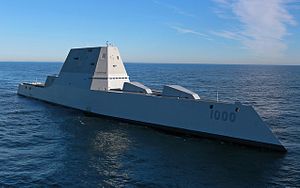The Navy’s newest futuristic weapon, the railgun, a weapons system that utilizes a combination of electric and magnetic force to fire a projectile, may skip an at-sea prototype phase and be directly outfitted on a Zumwalt-class destroyer, possibly the USS Lyndon B. Johnson, the third and final destroyer in its class, currently docked at Bath Iron Works, Maine.
The Navy has been testing railgun technology for several years now. Capable of firing a projectile 100 miles away and at the fraction of the cost of traditional missile projectiles, the railgun could potentially be a game changer in Pacific. Rear Admiral Matt Klunder told reporters “[It] will give our adversaries a huge moment of pause to go: ‘Do I even want to go engage a naval ship?’ Because you are going to lose. You could throw anything at us, frankly, and the fact that we now can shoot a number of these rounds at a very affordable cost, it’s my opinion that they don’t win.”
Traditional missile projectile systems on U.S. ships can range in costs from $500,000 to $1.5 million. The railgun projectile, weighing at roughly 23 lbs, costs $25,000, and can be fired at speeds of Mach 7 or 5,000 miles per hour. On top of the reduction in costs per projectile, the railgun limits the need to maintain a large quantity of heavy explosive tipped shells, increasing safety on board navy vessels, and reducing logistics costs and needs. Ships at sea can afford to stay out for longer periods without resupply, reducing the burden of at sea replenishment operations.
Lt. Cmdr. Hayley Sims, a Navy spokeswoman, stated “The Zumwalt-class is one of a number of options being explored for the electromagnetic railgun,” due to the size, weight and power requirements, some platforms will be better suited for the technology than others.”
The 15,700 ton vessel commonly referred to as the DDG-1000, features stealth technology and an all-electric integrated power system capable of generating 100 percent of the ship’s propulsion needs including electrical components and weapons systems. While moving at a speed of 20 knots, the ship produces an extra 58 MW of reserve power, allowing for future technological upgrades or new weapons systems.
Originally slated for 32 ships, the Navy scrapped the original plan in favor of just three as a result of the enormous price tag. Each DDG-1000 costs about $4 billion, with research and development the total program costs hover at roughly $23 billion.
Much criticism surrounding the purpose of the Zumwalt has caused analysts to question the role it will play in the Navy. As built, the DDG-1000 resembles an expensive shore-bombardment platform with its 155 mm guns, utilizing its stealth technology to rain fire on inland targets. With the outfitting of the Navy’s new railgun technology, the ship will now be capable of engaging other naval vessels instead of waiting for calmer waters to strike. The railgun will provide the U.S. Navy with flexibility on how it will use the stealth ship. The extreme speed of the projectiles fired from the railgun allows the Zumwalt to combat the growing ballistic missile threat, shooting down incoming projectiles How the Navy will utilize the Zumwalt is still up in the air, and three ships may prove to be simply insufficient.
Shawn Snow is a veteran of the U.S. Marine Corps and graduate of the Fletcher School of Law and Diplomacy specializing in Central and Southwest Asia. He served 10 years as a Signals Intelligence Analyst and completed multiple tours of duty to Iraq and Afghanistan. He has been published in Foreign Policy, The Diplomat, Washington Post and Small Wars Journal.

































